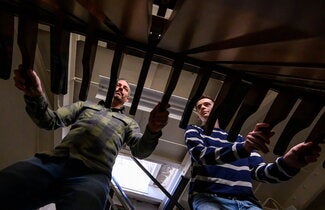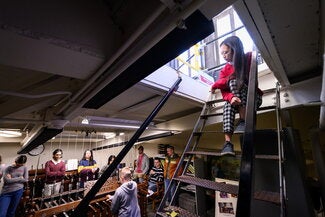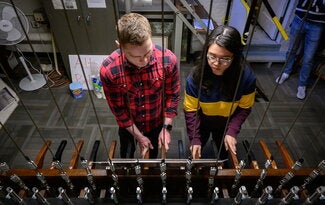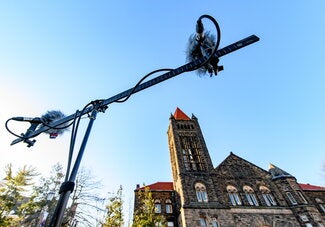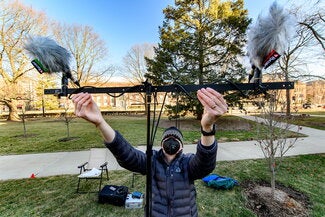The Altgeld Chimes: Songs for our Dear Old Illinois
The Altgeld Chimes: Songs for Our Dear Old Illinois is the first of its kind—an album completely dedicated to recording the bells of Altgeld Hall. This yearlong project is a culmination of hard work made possible by various members of the UIUC community.
In the album, the bells ring alongside everyday sounds of campus. Birds chirping, passers-by singing to Altgeld’s melodies, and the periodic halting of a bus dot the soundscape. Although some may interpret these sounds to be a dissonant clash with the music, they may also make campus life an audible, lived-in experience performed in tandem with the bells.
The Altgeld Chimes are a vibrant symbol of the university. I might argue that they ring the university to life. However, while the tower itself is highly visible, its performers are often not. We are hidden in the walls of Altgeld Hall’s domain. Yet, our music is always heard. And our community has been, continues to be, and always will be integral to that music."
— Michael Broussard, Spring 2023
Performers
Track numbers appear in parentheses.
| • Michael Broussard (1, 25, 27) | • Atharv Gudi (21) | • Josh Moore (4, 12) |
| • Sary Bseiso (33) | • Tina Horton (17, 23, 24, 25, 34) | • Spoorthi Nibhanupudi (33) |
| • Kenobi Carpenter (7) | • Cody Jones (17, 34) | • Annemarie Novack (2, 7, 8) |
| • Cope Cumpston (11, 13, 36, 37) | • Joseph Kim (5) | • Margot Pierce (3, 10, 29) |
| • Liam Flood (9, 15, 16, 32) | • Sarah Kwilecki (18, 19) | • Alyssa Shih (22) |
| • Nathaniel Gritton (30, 31) | • Albert Lua (35) | • Jonathon Smith (20, 26, 32) |
Just what makes those bells ring?
A note is played by pressing its pump handle on the chime stand in the playing room. Each handle is connected to a wire that extends through the ceiling, rising the 60 feet to connect to the clapper of its particular bell. The four lowest bells are also controlled by pedals, so that an agile player can sound three tones at once. There are four separate cables controlled by the Seth Thomas timer that connect to the four bells that play the Westminster Chime by external hammers.
The cables are exposed to heat, cold, rain, and ice. The reality of Illinois winters occasionally alarms a player; in the middle of a concert, a frozen cable means a bell doesn’t sound. The player must run to the tower to jiggle it free.
Playing bells is an experience that engages every sense. Chimesmaster Jonathon Smith marveled that when he plays the bells, it feels like he actually is "playing the tower."
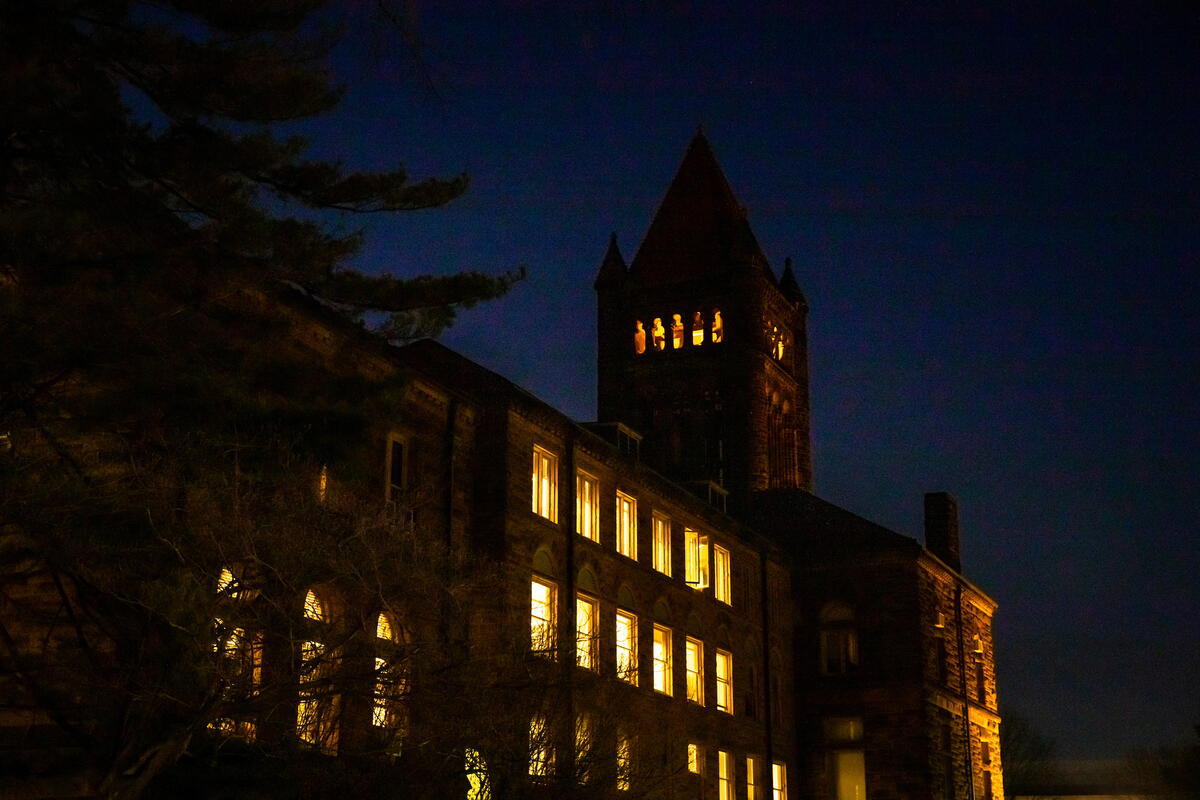
A brief history of the Altgeld Chimes
October 30, 1920, was a day like no other on the Urbana campus of the University of Illinois. It was its tenth homecoming celebration, in the autumn that marked the end of the daunting challenges of World War I and the influenza epidemic of 1918. The day’s pinnacle was the presentation of the Senior Memorial Chime—topped by a 17–7 victory over the University of Minnesota.
At 10 a.m., thousands of students, alumni, faculty, and locals gathered at Altgeld Hall to hear Victor Cullin present the chime; Robert Russell Ward accepted the gift on behalf of the Board of Trustees. President Kinley remarked, "No elaborate ceremony could express our appreciation of the grandeur of this idea so splendidly carried out."
And the Senior Memorial Chime pealed forth for the first time. McShane chimesplayer M. Harry Mettee began with "Illinois," followed by "Doxology, or Old Hundredth," "Illinois Loyalty," "Oskee Wow-Wow," "Coming through the Rye," and "America (My Country, ‘Tis of Thee)."
Chimesmasters over the years
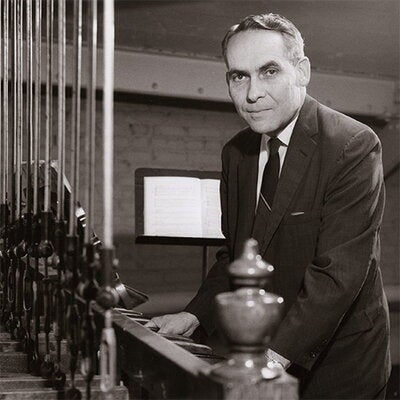
From the first years, chimesmasters have directed the program. They were mostly students until the chimes reopened in 1957. College of Commerce faculty Albert Marien was appointed in 1958, serving until 1994. During his long tenure he established a solid program with daily concerts.
Sue Wood was a lab coordinator at Illinois Natural History Survey and then the College of Veterinary Medicine when she was first drawn to the chimes in 1971. She and Marien became dedicated colleagues; in 1994 she took over as chimesmaster. For over forty years Wood was the daily face of the bells, delighting visitors with her tours and enthusiasm.
Musicology student Jonathon Smith took over following Woods’s retirement; he was followed by Tina Horton, chimesmaster during the centennial celebration. She knew the tower would close for an extended period during renovations to Altgeld Hall and recognized the importance of preserving its history and traditions. She and Smith produced a training manual. Horton and Liam Flood collected, catalogued and digitized photographs and archives, including the handwritten notebooks from 1966 that recorded the player of every single concert. These materials, thanks to Scott Schwartz, are now in the permanent collections of the Sousa Archives and Center for American Music.
The current chimesmaster as of 2023 is Michael Broussard.
A senior memorial gift to ring out across campus
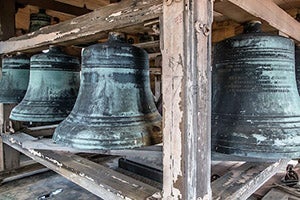
The Class of 1914 was intent on the tradition of graduating classes presenting a gift to the University—the Class of 1878 gave the clock on the Illini Union tower, and 1905 presented the imposing lamp at the front door of Altgeld Hall.
Pete Daugherty, editor of the Daily Illini, noted that Ohio State University had received a chime from the Classes of 1906-1914, and proposed the idea. It won the class vote after vigorous debate. With the guidance of Hazen Capron, the Classes of 1914-1919 each contributed toward the goal of $10,000 for an 11-bell chime.
15 Bells and Illini Loyalty
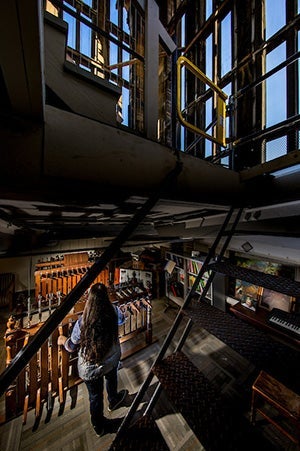
Additional contributions from the classes of 1920 and 1921 brought the fund to $11,000, which was enough for 13 bells. A committee chaired by professor James McLaren White, supervising architect of the university, selected McShane Bell Foundry Company of Baltimore to cast the bells. As the contract awaited final approval, Dean Clark asked if the proposed set could play the melody of "Illinois Loyalty." It could not—that required fifteen bells. He refused to approve the contract. The project was rescued by a fund remaining from the United States School of Military Aeronautics, a recently disbanded military installation on campus. The Board of Trustees allowed that money to be used to purchase the chime on the condition that a bell would be dedicated to the school.
The fifteen bells of the Altgeld Chimes range from low D to high G, but do not include an F natural in either octave. Ever since 1920, the ringers have had to transpose melodies to compensate for that missing note. An F natural bell eventually was cast in honor of chimesmaster Albert Marien, but the tower couldn’t support the additional weight. It hangs silent on display at Willard Airport. The largest bell, affectionately known as Big Ed, is five feet across, weighing one and a half tons. It is dedicated to Edmund Janes James, president of the university from 1904-1920. The entire set weighs in at some seven and a half tons.
The Westminster Chime
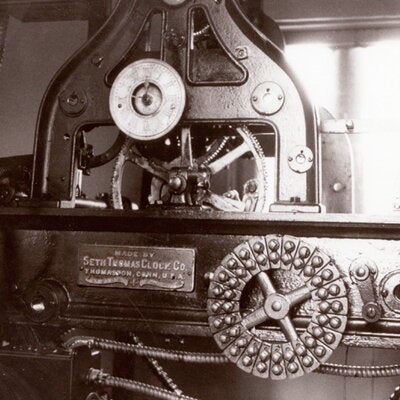
The Class of 1922 was eager to match the glory of the Altgeld Chime in selecting its senior memorial gift. It selected a timer from the Seth Thomas Clock Co. of Thomaston, Connecticut, to mechanize the playing of the traditional Westminster Chime that marks the quarter hours. It was installed on June 18, 1921. At first it rang every hour, even through the night, but after some objection was limited to between 7 a.m. and 11 p.m. and once for midnight.
After 2011 the mechanism was carefully maintained by Bill Buesing, campus electrician, who adjusted it for the twice-yearly shift around daylight savings time. He made sure the timer was oiled and in perfect condition to ring the bells on the centennial of its installation.
A second important addition in the 1920s was a practice keyboard built in the Physics Department. It operates like a xylophone so that ringers can learn melodies without actually sounding the bells. For the span of the current Altgeld Hall renovations, it has been moved to a practice room in the Music Building.
Maintenance and closures over the years
The working mechanisms of the Altgeld Chime are intricate and require vigilant attention. The simple striking of the clapper on the bell applies an immense amount of force; both for the preservation of the bells and for the quality of sound, the bells must be rotated periodically.
In the first years there was no plan for regular maintenance. By the early 1950s the transmission rods connecting the chimestand’s pumphandles to the bells showed so much wear that the chime was largely unplayable. The U of I Foundation took the lead to raise the necessary funds for a complete repair and upgrading, and "Hail to the Orange" rang out again in 1957.
In 2017 substantial repairs were again required. The tower closed for just over a year while the Verdin Company cleaned the bells and replaced the clappers and other
moving parts. Campus workers oversaw repair of the beams that support the bells themselves and refinished the playing console and practice keyboard. After that, safety regulations prohibited access up the tall ladder to the bells themselves and halted daily tours of the tower and playing chamber. All will be renovated during the Altgeld and Illini Halls project.
Special thanks
The Altgeld Ringers express our gratitude to Scott Fisher, who generously donated funds to produce this CD. The costs of recording were provided by a grant from SORF, the Student Org Resource Fee. The College of Liberal Arts and Sciences, the Department of Mathematics, and the Department of Musicology in the School of Music have supported the Chimes in many ways over time. Liam Flood, Altgeld Ringers historian, compiled the history and many photographs. Sara Benson, Assistant Professor and Copyright Librarian and her research assistant, Elizabeth Budd, oversaw the intricacies of copyright requirements. Graham Duncan was stalwart through wind, honking geese, and passing garbage trucks as he navigated the challenges of recording the bells.
